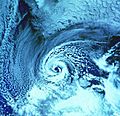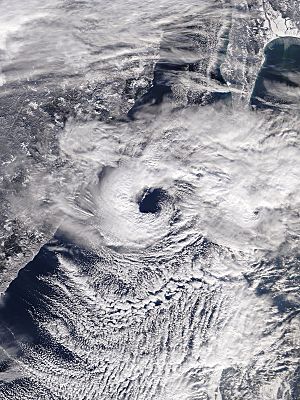Polar low facts for kids
A polar low is like a small, strong storm that forms over the cold ocean areas near the Earth's poles. These mini-storms are a type of low-pressure area, which means the air pressure in their center is much lower than the air around them. This causes winds to rush inwards and upwards, creating stormy weather.
Polar lows are usually quite small, less than 1,000 kilometers (about 620 miles) across. They also don't last very long, often only a day or two. You can find them in both the Northern Hemisphere and Southern Hemisphere, in the icy waters beyond the main polar front (which is where cold polar air meets warmer air).
Because they are small, short-lived, and happen in remote ocean areas, polar lows can be tricky to spot using regular weather forecasts. This makes them a challenge for ships and oil platforms operating in the far northern or southern seas.
Contents
What is a Polar Low?
A polar low is a special kind of weather system. It's part of a larger group called mesoscale weather systems. This means they are medium-sized, bigger than a single thunderstorm but smaller than a huge storm system that covers a whole country.
Over time, polar lows have been called by many different names, like comma cloud or Arctic hurricane. Today, the term "polar low" is usually saved for the strongest ones. These are the systems that bring very strong winds, at least gale force (which means winds blowing at 17 meters per second or about 38 miles per hour).
Where do Polar Lows Form?
Polar lows form over the ocean in very cold regions. This includes areas like the Barents Sea and the Sea of Japan. They need specific conditions to develop:
- Very cold air: The air above the ocean must be extremely cold.
- Relatively warmer water: The ocean water, while still cold, needs to be warmer than the air above it. This difference in temperature provides energy for the storm.
- Lack of strong winds higher up: If there are strong winds high in the atmosphere, they can rip apart the developing storm.
When these conditions are just right, the cold air picks up moisture and heat from the warmer ocean. This causes the air to rise quickly, creating the low-pressure area and forming the polar low.
Impact of Polar Lows
Even though they are small, polar lows can be very dangerous. They can bring:
- Strong winds: As mentioned, they often have winds strong enough to be called gale force.
- Heavy snow or rain: They can dump a lot of precipitation, often in the form of snow or sleet in these cold regions.
- High waves: The strong winds can whip up very large waves, which are a big threat to ships.
Because they are hard to predict, ships and other operations in polar regions must be very careful. Weather forecasters use special tools, like satellite images, to try and spot these fast-forming storms.
Images for kids
-
A polar low over the Barents Sea in February 1987
See also
 In Spanish: Baja polar para niños
In Spanish: Baja polar para niños
| Cyclones and Tropical cyclones of the World |
|---|
| Cyclone - Tropical - Extratropical - Subtropical - Mesocyclone - Polar cyclone - Polar low |




